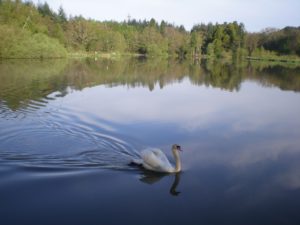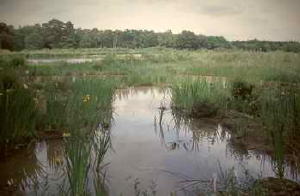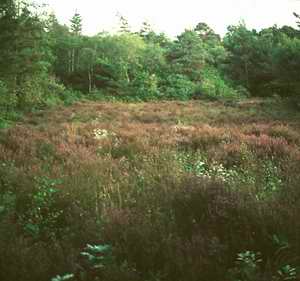The Country Park, which covers 114 acres consists of six main habitats types: freshwater, marshland, coniferous plantation, mixed broadleaved woodland, lowland heath and grassland. These habitats are easily accessible from a network of surfaced and un-surfaced paths.
Extensive deciduous and coniferous woodland are interspersed with pockets of lowland heath and grassland providing habitats for a range of visiting and resident wildlife. There is a substantial variety of wildlife, notably dragonflies and wildfowl, as well as other bird life, insects and mammals.
-
Lake
 The main feature of the Park is the lake. It has been in existence for some 230 years and over this period a diversity of species and communities have developed as the lake has matured.
The main feature of the Park is the lake. It has been in existence for some 230 years and over this period a diversity of species and communities have developed as the lake has matured.In Devon there is no other single inland water body equivalent in size, naturalness and diversity, than that found at Stover. The depth varies from 0.5 to 1.5 meters and extends to approximately 4.05 hectares (10 acres).
The major plant species in the lake is the white water lily, which can cover up to 70% of the open water in the summer. With a wide range of semi-natural habitats in the immediate vicinity, the lake has been colonised by local plants and invertebrates including several nationally scarce dragonflies.
There is a wide range of bird species that can been seen on the lake, particularly in the winter. The species include mallard, mute swan, pochard, tufted duck, kingfisher, great crested grebes, heron, cormorant, gull spp., moorhen and coot. Other species such as common sandpiper, teal, goose spp, shelduck, goosander, little grebe, pintail, wigeon, shoveler and vagrant sora rail 2000, night heron 2001, bittern 2002, will be seen from time to time.
If you are lucky enough you may see a grass snake swimming in the lake or slithering through the marsh. Otter, mink and water shrew have been regularly recorded.
-
Marsh
 Associated with the lake are valuable marsh areas with interesting flora, the northern marsh being considered the most important habitat. Its existence was a significant factor in the designation of SSSI status.
Associated with the lake are valuable marsh areas with interesting flora, the northern marsh being considered the most important habitat. Its existence was a significant factor in the designation of SSSI status.The marsh is an excellent example of succession, moving from reedmace and yellow iris through to alder and willow scrub. Also present is bog myrtle. The marshy margins are particularly important for rare flies with common reedmace and hemlock-water dropwort noted as significant species.
Winter feeders such as snipe frequent the marsh in numbers in excess of 250 individuals. Other species recorded in the marsh are water rail, water shrew, mink and harvest mice which have been found with nests from time to time.
Around the park and within the marsh small ponds have been created. The ponds have been made to increase and provide the specific habitat needed by freshwater invertebrates species such as the dragonflies. Stover has recorded a total of 24 out of the 26 species found in Devon due to the successful management of the freshwater systems.
-
Coniferous Plantation
 The existing coniferous plantations in the Park were established by the Forestry Commission between 1943 and 1966 on areas of lowland heath. These consist of single species stands of mainly Douglas fir, Norway spruce and Scots pine. Other blocks consist of sitka spruce, Japanese larch, coastal redwood and western hemlock.
The existing coniferous plantations in the Park were established by the Forestry Commission between 1943 and 1966 on areas of lowland heath. These consist of single species stands of mainly Douglas fir, Norway spruce and Scots pine. Other blocks consist of sitka spruce, Japanese larch, coastal redwood and western hemlock.The density of the plantation restricted an under storey or ground layer from developing. A thinning operation carried out in 1993 and 1994 has enabled a ground layer to develop in some of these plantations. The larch plantation in particular has a hazel and birch under storey.
In many areas natural regeneration of native broadleaved trees has occurred. These are generally scrubby, but some good stands of pedunculate oak and a few large beech are noticeable.
-
Mixed Woodland
![mixed_woodland[1]](https://beta.devon.gov.uk/stover/wp-content/uploads/sites/157/2016/02/mixed_woodland1-225x300.jpg) The main woodland within the park is predominately pedunculate oak and birch with some scots pine. The under storey has been dominated by rhododendron since the late 1920’s to the detriment of the habitat.
The main woodland within the park is predominately pedunculate oak and birch with some scots pine. The under storey has been dominated by rhododendron since the late 1920’s to the detriment of the habitat.Management of the under storey has allowed regeneration of hazel, aspen, spindle and holly among others. Decaying wood is left in situ for the rare longhorn beetle and stag beetle which depend on it for their survival.
Two other longhorn beetles are present. Greenfinch, siskin and other birds find shelter and protection in the winter whereas in the summer the tit species, spotted flycatcher, woodpecker and tawny owl among others breed. Other species to be found are roe deer, grey squirrels and dormice.
A diverse array of fungi can also be seen mainly during the autumn including the rare earthstar.
-
Heathland
 Much of the Bovey Basin, including Stover, was originally dominated by lowland heath and bog. Much of the lowland heath has been lost to afforestation and development and now covers only a fraction of its original area. These areas of heath are dominated by ling heather, with some cross leaved heath and bell heather.
Much of the Bovey Basin, including Stover, was originally dominated by lowland heath and bog. Much of the lowland heath has been lost to afforestation and development and now covers only a fraction of its original area. These areas of heath are dominated by ling heather, with some cross leaved heath and bell heather.The majority of the rich terrestrial fauna at Stover occurs in the relict areas of heathland. These heathland areas are especially important for the hoverfly species along with wasps, bees, ants and spiders. Larger mammals such as roe deer and fox are present, along with nightjar and adders.
-
Grassland
There are a number of small areas of grassland around the park. These consist mainly of thin linear edges to the woodlands and paths along woodland rides.
There are also three well defined larger areas managed specifically for grassland and meadow species to maximise their wildlife conservation value. They represent some of the most diverse areas in the park for flowering plants such as broad-leaved helleborine, common spotted-orchid, meadowsweet, ragged robin, vetch species and hemp agrimony.
A full range of species can be seen on our Species list page.
![grassland[1]](https://beta.devon.gov.uk/stover/wp-content/uploads/sites/157/2016/02/grassland1.jpg)